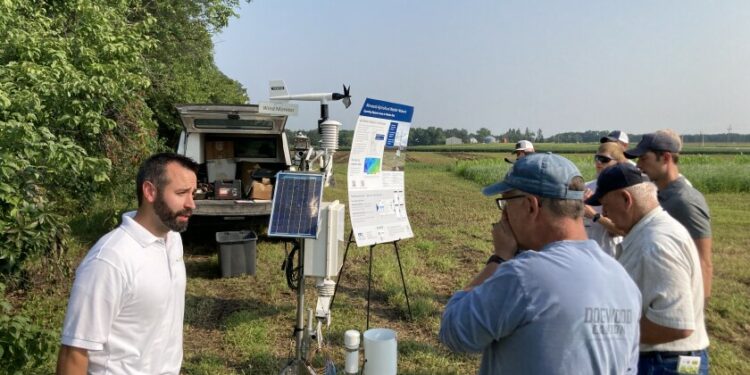Farmers have a lot to gain from a statewide agriculture weather network, and benefits of timely weather information is crucial for many precision agriculture technologies.
Minnesota farmers can expect to have that in the coming years.
The Minnesota Ag Weather Network (MAWN), managed by the state’s ag department, now operates 18 weather stations in the state with the help of local Soil and Water Conservation Districts. That’s four more since the expansion got underway this summer.
There are 24 more stations in Minnesota that are managed by the North Dakota Agricultural Weather Network (NDAWN), which started in 1989 and has a network of over 200 stations.
Stefan Bischof is a hydrologist with the Minnesota Department of Agriculture and program manager of the Minnesota network. He’s overseeing the current expansion and said MAWN will be able to grow quickly because of the online infrastructure of NDAWN and the support they’ve gotten from the staff.
All information gathered from the new Minnesota stations gets integrated into the server of North Dakota network,
which can be accessed for free by computer or mobile app.
“It helps us get ahead of the process, because they already have all the back end programming, front end programming, so we can get the station installed, and then they can get it online quicker,” Bischof said of the North Dakota network. “It saves us time and money being with the NDAWN.”
The Minnesota Ag Weather Network began in 2012 with four weather stations in east Otter Tail County where farmers plant in largely sandy soils. Then it kind of puttered out.
Only 10 stations were added over the next decade until 2023, when Minnesota Department of Agriculture received funding from the Clean Water Fund to expand statewide.
Stefan Bischof, left, answers questions about a weather station demonstration on Tuesday, Aug. 8, 2023, near Deer Creek, Minnesota.
Michael Johnson / Agweek
The $3 million will cover phase one of the expansion, Bischof said, which is to add 40 weather stations in the next two or three years. Stations within 20 miles of most agricultural areas is the ultimate goal of the project, so up to 80 stations may be necessary to achieve that.
“We received probably around 90 to 100 submissions of landowners across the state of Minnesota willing to host weather stations,” Bischof said.

A newly installed Minnesota Ag Weather Network station.
Contributed / Minnesota Department of Agriculture
Four new stations have been added to MAWN since July — at Northwest Research and Outreach Center, Crookston; Southern Research and Outreach Center, Waseca; Fertile, Polk County; and Fountain, Fillmore County — and the
data from them is live.
Two are at University of Minnesota research and outreach centers, and the others are at farms in the same region. Bischof said that’s the current approach of expanding.
“Part of the reason we’re focusing on the research and outreach centers is because they do a lot of research themselves and put together some guidelines as far as management decisions,” he said. “If they’re using the same weather information that farmers are using too, then it’s a lot easier to compare apples to apples, and just helps create that connection between the research implemented and then the application on the farm.”
Two of the new stations are in southeast Minnesota where state agencies are in phase one of an
EPA response workplan to address groundwater nitrate contamination
, and the data gathered can be used to help. A runoff risk tool incorporated in the network can forecast potential overland runoff up to 10 days, according to the Minnesota Department of Agriculture.
“What the stations do is help provide information on the characteristics of the soil, like with moisture in the soil and the precips that we’ve had, it could help guide that there may be a risk of runoff based on these weather conditions,” he said. “That would help guide the decision to maybe hold off on applying.”
Stefan Bischof shared how data is gathered and used by weather stations in areas like Otter Tail County in Minnesota on a visit Tuesday, Aug. 8, 2023, near Deer Creek, Minnesota.
Michael Johnson / Agweek
Bischof said the next round of installations will take place in a couple weeks in the Lamberton area, where three stations are expected to be built.
If the weather if favorable, he said they’ll continue to move forward on installing new stations.
“We’re hoping this year to add between 10-15 weather stations, and then we’ll be able to start again right away in the spring installing,” he said of 2025. “It’ll probably take a couple years before we get to that 40 additional.”
Due to delays on equipment and finalizing coordination between local SWCDs and the state’s climatology office, Bischof said they weren’t able to start installing until July.
“Next year, being able to start right away in the spring. That’ll definitely help us to be able to kick off the installation season,” he said.
Construction of new weather stations is done entirely by Minnesota Department of Agriculture staff, including Bischof, who said it’s a change of pace for them.
“We are field staff, researchers,” said Bischof. “But the line of work that we’ve been doing is anything from concrete work in the ground to wiring the programming to data loggers.”
It takes two days for one station to be built with the first day spent boring into the ground to make concrete footings.
“The next day we’ll install the sensors, raise the tower, and then do the wiring, which is kind of the detailed part of it,” he said. “We work long days. Typically try to have a crew of four people to get out there and work. And because there’s quite a bit of different tasks that need to be accomplished in the installation process.”
Why did it take so long for Minnesota to build its own weather network? Bischof isn’t sure, but he’s happy it’s happening.
“The expansion really was made possible by farmers and the citizens of Minnesota, just recognizing the need and how important it is,” he said. “It’s good to finally see it come to fruition, and our priority is being able to provide this information and the tools to farmers across the state.”

I am a general assignment agricultural reporter who covers everything from food to land, using multiple elements of media. I prioritize stories that amplify the power of people.
As an ag reporter, I’ve covered the opioid crisis, herding dogs, trade wars, snow-collapsed barns, COVID-19 pandemic, immigrant farmers, tree-range chickens, farmland transition, milking robots, world record pumpkins, cannabis pasteurization, cranberry country and horseradish kings.
I report out of northeast Rochester, Minnesota, where I live with my wife, Kara, and our polite cat, Zena. Email me at [email protected]
Source link : http://www.bing.com/news/apiclick.aspx?ref=FexRss&aid=&tid=66e841555aab4f868829eaae590beed0&url=https%3A%2F%2Fwww.agweek.com%2Fweather%2Fexpansion-of-minnesotas-ag-weather-network-finally-ramps-up&c=14472744396885941768&mkt=en-us
Author :
Publish date : 2024-09-15 23:36:00
Copyright for syndicated content belongs to the linked Source.








